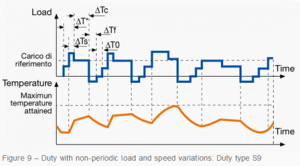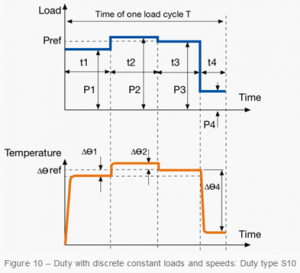5.2. Duty types
Definition :
The choice of a machine is also conditioned by its operating conditions. Thus we define 8 "services" or Duty Types according to the operating conditions ('Start, Nominal operation, idle operation, braking, stop).
In compliance with the classification of Std. IEC 60034-1 here are some indications regarding the duty types which are typically considered as reference to indicate the rating of the motor.
Continuous running duty (type S1)
Short-time duty (type S2)
Periodic duty (type S3-S8)
Intermittent periodic duty (Type S3)
Intermittent periodic duty with starting (Type S4)
Intermittent periodic duty with electric braking (Type S5)
Continuous-operation periodic duty (Type S6)
Continuous-operation periodic duty with electric braking (Type S7)
Continuous-operation periodic duty with related load / speed (Type S8)
Non-periodic duty (type S9)
Duty with discrete constant loads (and speeds) – type S10
Duty for equivalent loading
Definition : 5.2.1. Continuous running duty (type S1)
For a motor suitable to this duty type, the rating at which the machine may be operated for an unlimited period is specified. This class of rating corresponds to the duty type whose appropriate abbreviation is S1. DEFINITION – The duty type S1 can be defined as operation at a constant load maintained for sufficient time to allow the machine to reach thermal equilibrium. Where: ΔT – Time sufficient to allow the machine to reach thermal equilibrium | 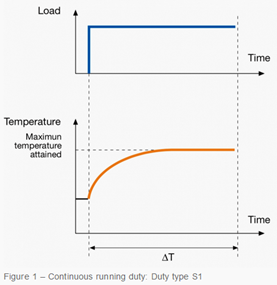 |
Definition : 5.2.2. Short-time duty (type S2)
5.2.2. Short-time duty (type S2)
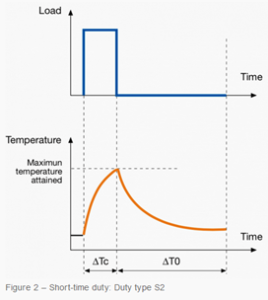 | For a motor suitable to this duty type, the rating at which the machine, starting at ambient temperature, may be operated for a limited period is specified. This class of rating corresponds to the duty type whose appropriate abbreviation is S2. DEFINITION – The duty type S2 can be defined as operation at constant load for a given time, less than that required to reach thermal equilibrium, followed by a time de-energized and at rest of sufficient duration to re-establish the equilibrium between the machine temperature and that of the coolant temperature. A complete designation provides the abbreviation of the duty type followed by an indication of the duration of the duty (S2 40 minutes). • ΔTc – Operation time at constant load • ΔT0 – Time de-energized |
Definition : 5.2.3. Periodic duty (type S3-S8)
For a motor suitable to this duty type, the rating at which the machine may be operated in a sequence of duty cycles is specified. With this type of duty, the loading cycle does not allow the machine to reach thermal equilibrium.
This set of ratings is linked to a defined duty type from S3 to S8 and the complete designation allows identification of the periodic duty.
If no otherwise specified, the duration of a duty cycle shall be 10 minutes and the cyclic duration factor shall have one of the following values: 15%, 25%, 40%, 60%.
The cyclic duration factor is defined as the ratio between the period of loading, including starting and electric braking, and the duration of the duty cycle, expressed as a percentage.
Definition : 5.2.3.1. Duty type S3
(Intermittent periodic duty) DEFINITION – The duty type S3 is defined as a sequence of identical duty cycles, each including a time of operation at constant load and a time de-energized and at rest. The contribution to the temperature-rise given by the starting phase is negligible. A complete designation provides the abbreviation of the duty type followed by the indication of the cyclic duration factor (S3 30%). • ΔTc – Operation time at constant load • ΔT0 – Time de-energized and at rest • Cyclic duration factor = ΔTc/T | 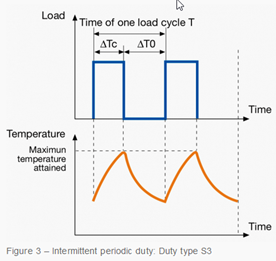 |
Definition : 5.2.3.2. The duty type S4
 | (Intermittent periodic duty with starting) DEFINITION – The duty type S4 is defined as a sequence of identical duty cycles, each cycle including a significant starting time, a time of operation at constant load and a time de-energized and at a rest. A complete designation provides the abbreviation of the duty type followed by the indication of the cyclic duration factor, by the moment of inertia of the motor JM and by the moment of inertia of the load JL, both referred to the motor shaft (S4 20% JM = 0.15 kg m2 JL = 0.7 kg m2). • ΔT* – Starting/accelerating time • ΔTc – Operation time at constant load • ΔT0 – Time de-energized and at rest • Cyclic duration factor = (ΔT* + ΔTc)/ T |
Definition : 5.2.3.3. The duty type S5
(Intermittent periodic duty with electric braking) DEFINITION – The duty type S5 is defined as a sequence of identical duty cycles, each cycle consisting of a starting time, a time of operation at constant load, a time of electric braking and a time de-energized and at a rest. A complete designation refers to the duty type and gives the same type of indication of the previous case. • ΔT* – Starting/accelerating time • ΔTc – Operation time at constant load • ΔTf – Time of electric braking • ΔT0 – Time de-energized and at rest • Cyclic duration factor = (ΔT* + ΔTc + ΔTf)/ T | 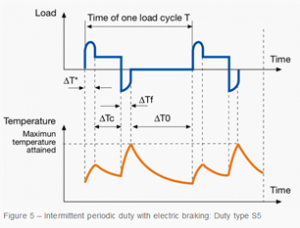 |
Definition : 5.2.3.4. The duty type S6
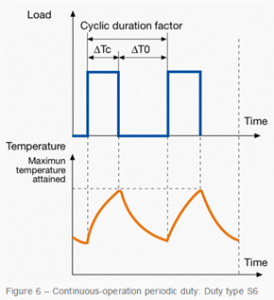 | (Continuous-operation periodic duty) DEFINITION – The duty type S6 is defined as a sequence of identical duty cycles, each cycle consisting of a time of operation at constant load and a time of operation at no-load. There is no time de-energized and at rest. A complete designation provides the abbreviation of the duty type followed by the indication of the cyclic duration factor (S6 30%). • ΔTc – Operation time at constant load • ΔT0 – Operation time at no load • Cyclic duration factor = ΔTc/ΔT0 |
Definition : 5.2.3.5. The duty type S7
(Continuous-operation periodic duty with electric braking) DEFINITION – The duty type S7 is defined as a sequence of identical duty cycles, each cycle consisting of a starting time, time of operation at constant load and a time of electric braking. There is no time de-energized and at rest. A complete designation provides the abbreviation of the duty type followed by the indication of both the moment of inertia of the motor JM and the moment of inertia of the load JL (S7 JM = 0.4 kg m2 JL = 7.5 kg m2). • ΔT* – Starting/accelerating time • ΔTc – Operation time at constant load • ΔTf – Time of electric braking • Cyclic duration factor = 1 |  |
Definition : 5.2.3.6. The duty type S8
(Continuous-operation periodic duty with related load / speed) DEFINITION – The duty type S8 is defined as a sequence of identical duty cycles, each consisting of a time of operation at constant load corresponding to a predetermined speed of rotation, followed by one or more times of operation at other constant loads corresponding to different speeds of rotation. There is no time de-energized and at rest. A complete designation provides the abbreviation of the duty type followed by the indication of the moment of inertia of the motor JM and by the moment of inertia of the load JL, together with the load, speed and cyclic duration factor, for each speed condition (S8 JM = 0.7 kg m2 JL = 8kgm2 25kW 800rpm 25% 40kW 1250rpm 20% 25 kW 1000 rpm 55%). • ΔT* – Starting/accelerating time • ΔTc1; ΔTc2; ΔTc3 – Operation time at constant load • ΔTf1; ΔTf2 – Time of electric braking • Cyclic duration factor = (ΔT*+ΔTc1)/T; (ΔTf1+ΔTc2)/T; (ΔTf2+ΔTc3)/T |
Definition : 5.2.4. Non-periodic duty (type S9)
Duty with non-periodic load and speed variations For a motor suitable to this duty type, the rating at which the machine may be operated non-periodically is specified. This class of rating corresponds to the duty type whose appropriate abbreviation is S9. DEFINITION – The duty type S9 is defined as a duty in which generally load and speed vary non-periodically within the permissible operating range. This duty includes frequently appplied overloads which may greatly exceed the reference load. • ΔT* – Starting / accelerating time • ΔTs – Time under overload • ΔTc – Operation time at constant load • ΔTf – Time of electric braking • ΔT0 – Time de-energized and at rest |
Definition : 5.2.5. Duty with discrete constant loads and speeds (type S10)
For a motor suitable to this duty type, the rating at which the machine may be operated with a specific number of discrete loads for a sufficient time to allow the machine to reach thermal equilibrium is specified. The maximum permissible load within one cycle shall take into consideration all parts of the machine (the insulation system, bearings or other parts with respect to thermal expansion). The maximum load shall not exceed 1.15 times the value of the load based on duty type S1. Other limits as regards the maximum load may be given in terms of limits of temperature of the winding. The minimum load may have the value zero, when the machine operates at no-load or is de-energized and at rest. This class of rating corresponds to the duty type whose appropriate abbreviation is S10. DEFINITION – The duty type S10 is defined as the operation characterized by a specific number of discrete values of load maintained for a sufficient time to allow the machine to reach thermal equilibrium. The minimum load during a duty cycle may have value zero and be relevant to a no- load or rest condition. A complete designation provides the abbreviation of the duty type followed by the indication of the per unit quantities p/Δt for the partial load and its duration, and by the indication of the per unit quantity TL which represents the thermal life expectancy of the insulation system related to the thermal life expectancy in case of duty type S1 with rated output, and by the quantity r which indicates the load for a time de-energized and at rest (S10 p/Δt = 1.1/0.4; 1/0.3; 0.9/0.2; r/0.1 TL = 0.6). Where: • ΔΘ1; ΔΘ2; ΔΘ2 – Difference between the temperature rise of the winding at each of the various loads within one cycle and the temperature rise based on duty cycle S1 with reference load • ΔΘref – Temperature at reference load based on duty type S1 t1; t2; t3; t4: time of a constant load within a cycle P1; P2; P3; P4: time of one load cycle • (Pref: reference load based on duty type S1) |
Definition : 5.2.6. Duty for equivalent loading
For a motor suitable to this duty type, the rating, for test purposes, at which the machine may be operated at constant load until thermal equilibrium is reached and which results in the same stator winding temperature rise as the average temperature rise during one load cycle of the specified duty type.
This class of ratings, if applied, corresponds to the duty type designated “equ”.


